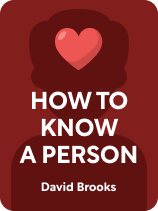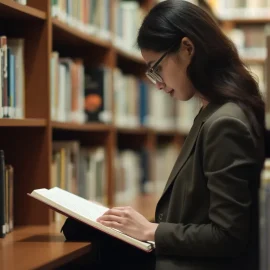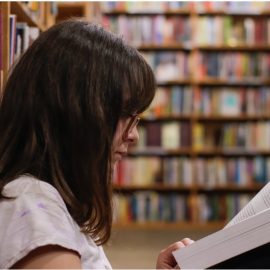

This article is an excerpt from the Shortform book guide to "How to Know a Person" by David Brooks. Shortform has the world's best summaries and analyses of books you should be reading.
Like this article? Sign up for a free trial here.
What are the best How to Know a Person quotes? What happens when you’re too absorbed in your own life?
In How to Know a Person (2023), David Brooks argues that our relationships are in decline—and the morality of our society with them—because many of us have lost touch with our ability to know other people well. Brooks writes that knowing others enables us to see across political divides, racial lines, and geographic distances, allowing us to truly understand one another.
Keep reading to discover four How to Know a Person quotes to get the main ideas from the book.
Quotes From How to Know a Person
In How to Know a Person, New York Times columnist David Brooks argues that our ability to truly understand and connect with others is in crisis. As a result, we have problems like political polarization, mental health issues, and an epidemic of loneliness. Brooks contends that by rediscovering the lost art of “knowing” people, we can bridge divides, foster empathy, and rebuild our moral character.
Below we’ll look at four How to Know a Person quotes that perfectly encapsulate the book.
“She who only looks inward will find only chaos, and she who looks outward with the eyes of critical judgment will find only flaws. But she who looks with the eyes of compassion and understanding will see complex souls, suffering and soaring, navigating life as best they can.”
We’re all at the center of our own worlds, and we naturally center ourselves in our thoughts and our conversations. Brooks explains that by stepping back from your ego and how it wants you to see the world, you can make more room for other people. A great place to start is in the conversations you have every day with others. We all love talking about ourselves, and we sometimes find it challenging to talk about someone else for a change. By learning to resist the tendency to turn the conversation back to yourself—like by telling a friend who’s having trouble with a colleague about your own struggles at work—you can do a better job of being present with them.
Another way Brooks recommends exercising care for others is to pay attention to social situations and to make them more comfortable and equitable for everyone. If there’s a major difference between you and another person—whether in political views or in the amount of power or access you have in a given context—it’s easy for you to make them feel misunderstood or excluded. Brooks advises working to put everyone on even footing so you can exchange ideas respectfully and authentically. For example, you might go into a meeting at work with more seniority than others in the room. But if you take the time to discuss everyone’s opinions, you’ll put your junior colleagues at ease and help them feel their voices are heard.
“The greatest thing a person does is to take the lessons of life, the hard knocks of life, the surprises of life, and the mundane realities of life and refine their own consciousness so that they can gradually come to see the world with more understanding, more wisdom, more humanity, and more grace.”
Brooks explains that it’s important to learn to see where people are in their life. To understand how each person is moving through their personal challenges and circumstances, it’s useful to think about where their focus lies. For example, some people are in the process of building an identity and cultivating a unique set of skills. Others are focused on finding important social connections, whether a partner or a close group of friends. Still others are working on building their career or finding a way to make the world a better place.
Brooks explains that learning to recognize these stages can not only help you support others through periods of transition—which are demanding and challenging—but can also help you understand a basic truth about life: that we often have to change and grow to move forward.
“Even when you know someone well, I find that if you don’t talk about the little things on a regular basis, it’s hard to talk about the big things.”
One way to show people you see and value them is to be present in the moments you share with them each day, even when you’re doing something routine. Brooks notes that you probably spend most of your time doing the mundane things that make up everyday life: collaborating on projects with your coworkers, cooking dinner with your partner, driving to school with your kids, striking up a conversation with the neighbors, and so on. He recommends learning to see these moments as chances to engage with the people you share them with: to bring your whole self to those moments and to enjoy seeing how others navigate their lives.
Brooks explains that when you do something with another person, like writing code together or looking at the same painting, you’re often side-by-side with them—but you may see things differently from your seemingly similar vantage points. Focusing on something together is an opportunity to see their unique perspective.
“Our schools and other institutions have focused more and more on preparing people for their careers, but not on the skills of being considerate toward the person next to you. The humanities, which teach us what goes on in the minds of other people, have become marginalized.”
Brooks contends that even as you ask questions to learn the story of someone’s life from their perspective, you can use your perspective to help them see themselves more clearly. We have a natural tendency to arrange our experiences into neat stories. But sometimes, these stories aren’t entirely accurate. Brooks explains that you can pay attention to the ways in which a person’s story doesn’t fully represent who they are or capture the direction their life seems to be going in. Then, you might be able to help them change that story.
He emphasizes that when you listen to someone else’s story, you can simultaneously fully accept and respect them as a person and also help them make their story more honest. In doing so, you help them to see the best in themself and the person they’re becoming. For example, you might have a friend who consistently portrays themselves as always moving forward and never encountering setbacks. You can acknowledge their achievements but also gently point out that the challenges they’ve faced have made them more resilient as a person. By encouraging your friend to include these more difficult episodes in the story they tell, you can help them build a more authentic and balanced view of who they are.

———End of Preview———
Like what you just read? Read the rest of the world's best book summary and analysis of David Brooks's "How to Know a Person" at Shortform.
Here's what you'll find in our full How to Know a Person summary:
- The benefits of really getting to know other people
- How to better understand people on a personal level
- Why our morality and relationships are in a crisis






